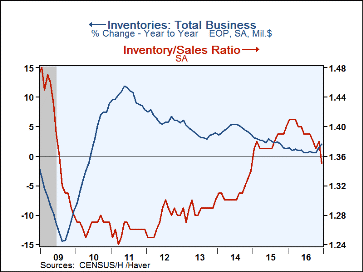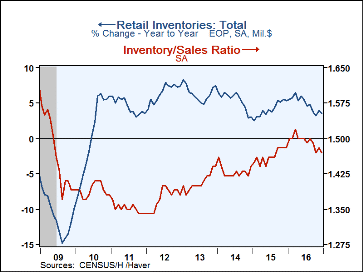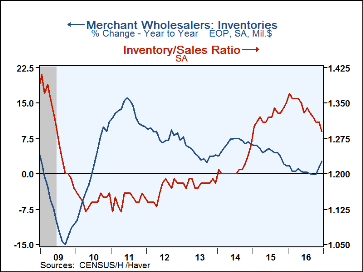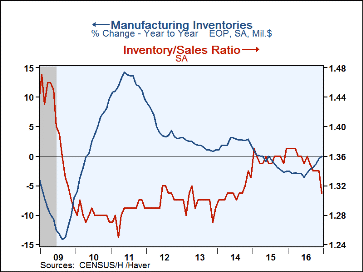 Global| Feb 15 2017
Global| Feb 15 2017U.S. Business Sales Jumped While Inventories Slowed in December
by:Sandy Batten
|in:Economy in Brief
Summary
Business sales jumped 2.0% m/m (5.2% y/y) in December. This was the largest monthly increase since March 2011 and the largest yearly increase since May 2012. All three major categories (retail, wholesale and manufacturing) posted [...]
Business sales jumped 2.0% m/m (5.2% y/y) in December. This was the largest monthly increase since March 2011 and the largest yearly increase since May 2012. All three major categories (retail, wholesale and manufacturing) posted solid gains with yearly increases in each category the largest since early 2012. However, for all of 2016, total sales edged up only 0.1%, reflecting a 2.7% annual increase in retail sales but declines in both wholesale and manufacturing sales.
Total business inventories rose 0.4% m/m (2.0% y/y) in December, down from the 0.8% m/m increase reported for November. The December increase was generally in line with market expectations. For all of 2016, business inventories rose 2.0%, up from a 1.3% gain in all of 2015. Retail inventories jumped 3.5% in 2016 and wholesale inventories were up 2.6%, while manufacturing inventories were little changed.
For December, retail inventories edged up 0.1% m/m (3.5% y/y) but when autos were excluded rose a more significant 0.4% m/m (1.4% y/y) gain. This reflected a 0.6% m/m decline in auto inventories (but auto inventories were up 7.6% from year ago). Inventories of building materials increased 0.3% m/m in December while inventories at food and beverage stores jumped 0.8% m/m. Wholesale inventories rose 1.0% m/m (2.6% y/y) in December, the same increase as in November. And manufacturing inventories nudged up just 0.1% (-0.1% y/y) following a 0.5% m/m jump in November.
With the jump in sales relative to inventories in December, inventory-to-sales ratios declined across the board. The overall ratio fell to 1.35 from 1.38 in November. This is the lowest reading on this measure since December 2014. The retail inventory-to-sales ratio edged down to 1.47 from 1.48. The wholesale I/S ratio continued its rather steady decline over the past year, falling to 1.29 - its lowest reading since December 2014. And the manufacturing I/S ratio dropped to 1.31 in December, its lowest reading since September 2014 and its biggest monthly decline since November 2013.
The manufacturing and trade data are in Haver's USECON database.
| Manufacturing & Trade | Dec | Nov | Oct | Dec Y/Y | 2016 | 2015 | 2014 |
|---|---|---|---|---|---|---|---|
| Business Inventories (% chg) | 0.4 | 0.8 | -0.1 | 2.0 | 2.0 | 1.3 | 3.7 |
| Retail | 0.1 | 0.9 | -0.4 | 3.5 | 3.5 | 5.3 | 3.0 |
| Retail excl. Motor Vehicles | 0.4 | 0.5 | -0.2 | 1.4 | 1.4 | 4.1 | 2.6 |
| Merchant Wholesalers | 1.0 | 1.0 | -0.1 | 2.6 | 2.6 | 1.7 | 6.5 |
| Manufacturing | 0.1 | 0.5 | 0.1 | -0.1 | -0.1 | -2.6 | 1.8 |
| Business Sales (% chg) | |||||||
| Total | 2.0 | 0.3 | 0.7 | 5.2 | 0.1 | -2.7 | 2.8 |
| Retail | 1.2 | 0.0 | 0.8 | 4.6 | 2.7 | 1.6 | 3.9 |
| Retail excl. Motor Vehicles | 0.6 | 0.1 | 0.8 | 3.8 | 2.4 | 0.2 | 3.2 |
| Merchant Wholesalers | 2.6 | 0.5 | 1.1 | 6.8 | -0.2 | -4.3 | 3.6 |
| Manufacturing | 2.2 | 0.3 | 0.2 | 4.3 | -1.8 | -4.4 | 1.2 |
| I/S Ratio | |||||||
| Total | 1.35 | 1.38 | 1.37 | 1.40 | 1.39 | 1.38 | 1.31 |
| Retail | 1.47 | 1.48 | 1.47 | 1.48 | 1.49 | 1.46 | 1.43 |
| Retail excl. Motor Vehicles | 1.25 | 1.26 | 1.25 | 1.28 | 1.27 | 1.27 | 1.24 |
| Merchant Wholesalers | 1.29 | 1.31 | 1.31 | 1.35 | 1.34 | 1.32 | 1.21 |
| Manufacturing | 1.31 | 1.34 | 1.34 | 1.37 | 1.35 | 1.36 | 1.31 |
Sandy Batten
AuthorMore in Author Profile »Sandy Batten has more than 30 years of experience analyzing industrial economies and financial markets and a wide range of experience across the financial services sector, government, and academia. Before joining Haver Analytics, Sandy was a Vice President and Senior Economist at Citibank; Senior Credit Market Analyst at CDC Investment Management, Managing Director at Bear Stearns, and Executive Director at JPMorgan. In 2008, Sandy was named the most accurate US forecaster by the National Association for Business Economics. He is a member of the New York Forecasters Club, NABE, and the American Economic Association. Prior to his time in the financial services sector, Sandy was a Research Officer at the Federal Reserve Bank of St. Louis, Senior Staff Economist on the President’s Council of Economic Advisors, Deputy Assistant Secretary for Economic Policy at the US Treasury, and Economist at the International Monetary Fund. Sandy has taught economics at St. Louis University, Denison University, and Muskingun College. He has published numerous peer-reviewed articles in a wide range of academic publications. He has a B.A. in economics from the University of Richmond and a M.A. and Ph.D. in economics from The Ohio State University.










